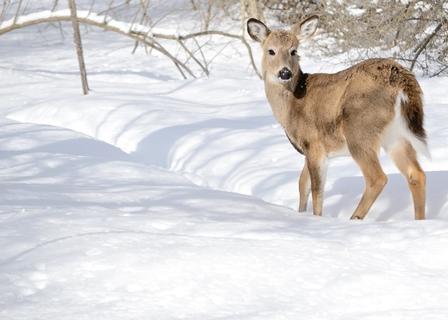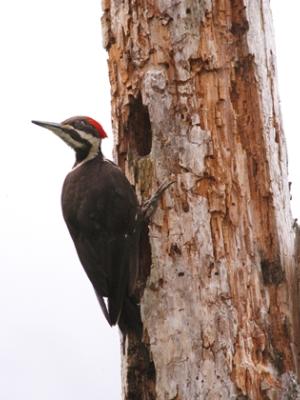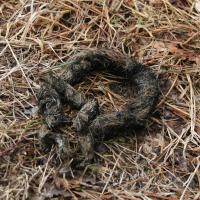- Tags:
- Wildlife

A curious whitetail deer stops to see who is walking in the winter woods. Dreamstime.com
"How come we never seem to see many animals when we're hiking?"
It's a familiar lament from those who wish to get more out of precious free time enjoying the peace of the forest and freedom of the hills. I've got a few time-tested and simple tips to help maximize your chances to encounter wildlife, find wildlife signs and experience more when you take to the woods.
Shhhh

Slow down
While you’re at it, sit down. Take a page from the still-hunter’s book and stop moving. Sitting still with eyes closed will heighten your other senses and awareness of sounds and smells around you. When you blend into the forest rather than stand out, birds or mammals moving nearby are less likely to detect your presence, and you’ll become more adept at both seeing and hearing them. Practice your observation skills when watching a backyard bird or chipmunk. Are they aware you are watching?
Get off the beaten path
Since you’re not moving fast and possibly meandering off trail on a random bushwhack, you might as well ditch the whole destination thing entirely. The very best walks in the woods are often open-ended exploration where the journey itself becomes as important as any destination. Be safe and tell others where you’ll be hiking and when you expect to return, but remain open to exploring short side-trips. Even hiking a hundred feet off-trail to sit quietly beneath a tree to eat lunch can be a very different experience than dining at a popular summit or along a busy trail.
Leave your dog at home this time
I rarely see the wildlife my dog scares off with barking when she picks up a scent. Leaving your dog at home better equips you to remain both quiet and motionless. Of course those who hunt game birds will say the reverse is true. Dogs have finely adapted the ability to sense the unseen.
Seek the edges

Consider forest types
Look at any aerial photo or Google Earth image. Conifer woods of pine, hemlock and spruce will host different suites of species than deciduous forests of maple, beech, birch and oak. For example, red-breasted nuthatches are generally found in and near conifer woods while white-breasted nuthatches are generally found in deciduous woods. Other species are considered “habitat generalists” found at edges of mixed woods and even in suburban backyards. A white-tailed deer or gray squirrel might be found anywhere, while pine martins and spruce grouse require more specialized habitat. And while the open and airy, yet barren understory of pure pine and hemlock offers little in the way of food or cover, people tend to visit these sites because they afford great views into the surrounding woods. They are, however, less likely to host foraging wildlife.
Seek water
On the contrary, linear “riparian” corridors of wetlands, stream edges and pond shores feature higher densities of wildlife. A quiet beaver pond offers an excellent opportunity to see a wide suite of wetland species. You may find turtles, frogs, ducks, herons, flycatchers, moose, muskrats, beaver, otters and bats as well as mayflies, caddis flies and dragonflies. Other perhaps less exciting species of insects include biting blackflies, ticks, mosquitoes and deerflies. In order to remain comfortable while sitting motionless, be sure to bring insect repellent or a head net.
Speaking of bats and beaver ponds, evening hours and the early morning hours are often the very best times to see wildlife. “Crepuscular” species are those active at both dawn and dusk as opposed to the “diurnal” species active in daytime. The nocturnal species active only at night may be creatures you only hear rustling in leaves, the “things that go bump in the night.” Try sitting at a beaver pond just before sunset. Remember to bring a flashlight so you can find your way back to your car at the trailhead. Weather considerations also play a part in wildlife activity. Few animals are active in mid-summer during the hottest part of the day. When the weather is rainy or windy, most animals seek shelter to conserve energy. You should, too.
Expect the unexpected

More telltale signs
Even if you do not see or hear birds or mammals in dramatic fashion in the woods, you should be alert for telltale signs of wildlife. When you see mud or sand while following aforementioned riparian corridors along brooks and ponds, inspect the ground for tracks. Of course the tracking gets even better once the snow covers the ground. Other signs of wildlife include browse where ragged twigs were nipped by passing deer or neatly clipped by the sharp incisors of rabbits, hare or porcupines.
Scent marking and scat

Encountering wildlife is often a simple matter of good luck—being in the right place at the right time. It helps to slow down and tune in to your surroundings. Ditch the Discovery Channel dramatic wildlife documentary expectations. With busy, fast-paced lives, it’s always good to recalibrate to the slower, quieter pace and the daily and seasonal rhythms of the forests around us. Have fun. Stay safe, warm and dry, and enjoy your precious time in the woods.
Naturalist Dave Anderson is director of education for the Society for the Protection of New Hampshire Forests. He may be reached via e-mail at danderson@forestsociety.org.
